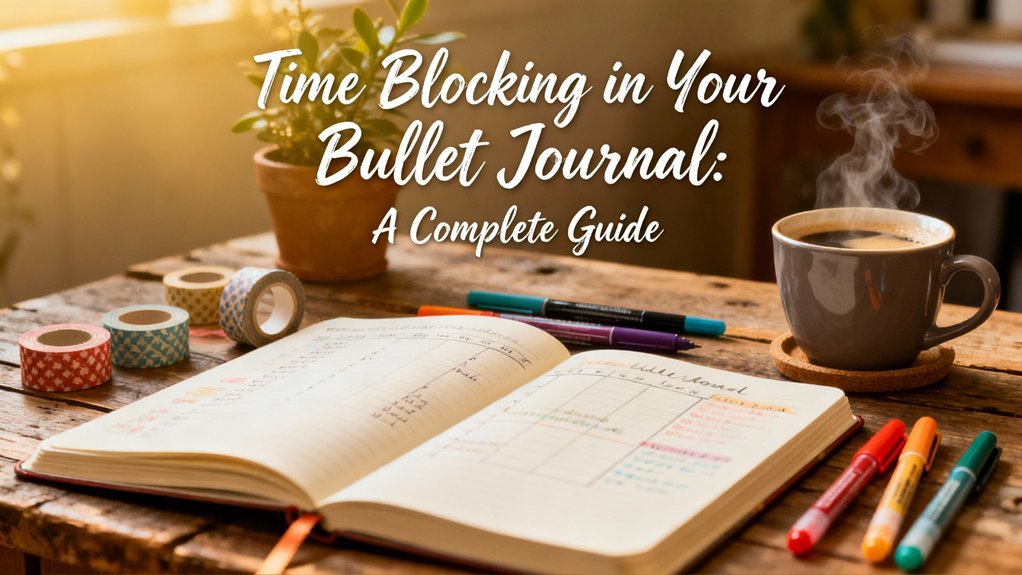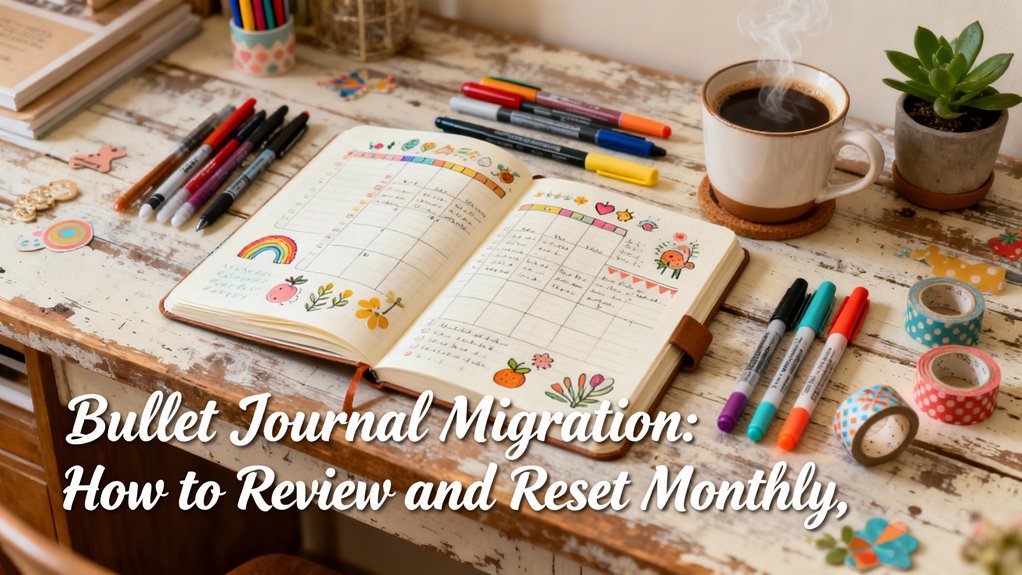Start with just three core components: an index, monthly log, and daily rapid logging using one notebook and pen. Design layouts you'll complete in under five minutes by focusing on essential elements like date headers, top three priorities, and time-blocked tasks. Choose only two to three habits that align with your actual values, not external expectations. Build weekly spreads instead of daily pages to accommodate schedule changes without redesigning entire systems. Your practice becomes sustainable when you prioritize function over perfection and establish review routines that match your lifestyle's reality rather than aspirational ideals.
Key Takeaways
- Start with three core components—index, monthly log, and daily rapid logging—using only one notebook and pen.
- Complete daily layouts in under five minutes by focusing on date, top three priorities, time-blocks, and symbols.
- Track only two to three habits aligned with personal values; review daily for five minutes and weekly for fifteen.
- Use weekly spreads for flexibility and limit task migration to ten items monthly to prevent overwhelm.
- Evolve your system through consistent reviews while maintaining momentum by prioritizing function over perfect aesthetics.
Start With the Bare Minimum: Your Essential Pages Only

The fastest way to abandon your bullet journal is to overwhelm yourself with elaborate spreads you don't need.
Start simple or quit fast: elaborate spreads kill bullet journals before they begin.
Strip your practice down to three core components: an index, monthly log, and daily rapid logging. That's it. You'll discover these essential supplies create maximum functionality with minimal effort.
Your minimalist tools should include one notebook and one pen. Resist the urge to collect elaborate supplies before you've established your practice.
Innovation thrives on constraints, not complexity.
Focus exclusively on capturing tasks, events, and notes. Skip the mood trackers, habit grids, and decorative headers until you've maintained consistent daily logging for thirty days. This proves you've built the foundation.
Remember that feeling overwhelmed or disorganized isn't a personal flaw—it's simply a signal that your current system needs adjustment.
When you're ready to expand, add one new element at a time. Test it for two weeks. If it doesn't serve a clear purpose, eliminate it.
This systematic approach alters your bullet journal from an intimidating creative project into a sustainable productivity tool.
Design Layouts You Can Complete in Under Five Minutes
Speed is your secret weapon for consistency—if a layout takes too long, you won't maintain it.
Focus on three time-saving strategies: minimalist weekly spreads with simple boxes and lines, daily logs that capture only tasks and events, and pre-planned collection pages you can replicate without thinking.
Master these efficient templates, and you'll complete your setup in minutes instead of hours.
The key is making planning and productivity fun rather than treating it as another overwhelming chore on your list.
Minimalist Weekly Spread Templates
Five core layouts form the foundation of any quick weekly spread: the vertical column method, horizontal time blocks, task lists with day headers, rolling dailies, and the hybrid grid.
Each template embraces minimalist design principles while allowing you to capture weekly themes efficiently.
Choose your template based on your workflow:
- Vertical columns divide your page into seven equal sections for instant visual clarity
- Horizontal blocks allocate specific time windows to high-priority tasks throughout your week
- Day headers with bullets eliminate unnecessary decoration while maintaining functionality
- Rolling dailies adapt to variable task volumes without wasting space
- Hybrid grids combine appointments and tasks in one cohesive view
Test each layout for two weeks.
You'll discover which structure supports your natural planning rhythm without forcing unnecessary complexity into your practice.
Essential Daily Log Elements
While weekly spreads establish your organizational framework, daily logs determine whether you'll actually maintain your journal long-term. Speed matters—if your daily log formats take longer than five minutes, you'll abandon them. Strip your pages down to essential log components that actually serve you.
| Element | Time Investment |
|---|---|
| Date header | 15 seconds |
| Top 3 priorities | 45 seconds |
| Time-blocked tasks | 90 seconds |
| Rapid logging symbols | 60 seconds |
| Evening reflection | 90 seconds |
You don't need decorative headers or color-coded systems. Use bullet points, dashes, and circles—nothing more. Time-block your priorities against your actual schedule. At day's end, migrate incomplete tasks forward. This systematic approach alters journaling from artistic hobby into sustainable productivity tool. You'll build momentum through consistency, not perfection.
Pre-Planned Collection Pages
Collection pages fail when you treat them as elaborate art projects rather than functional reference systems.
You'll maintain consistency by designing simple templates that optimize your page organization process.
Speed-focused collection themes that work:
- Book tracker: Title, author, date finished—three columns, done
- Habit grid: 31-day checkbox matrix requiring only a ruler
- Expense log: Date, item, amount in pre-drawn rows
- Project dashboard: Four quadrants for tasks, deadlines, notes, resources
- Contact list: Name and primary info in uniform spacing
Pre-draw your collections during monthly setup using basic shapes and lines.
Skip decorative headers and intricate borders. You're building a reference tool, not a museum piece.
When collection themes serve specific purposes with clear page organization, you'll actually use them.
That's sustainable practice.
Choose Tracking Habits That Actually Matter to You
Your bullet journal will only work if you're tracking habits that connect to your core values and life goals.
Begin with two or three small habits you genuinely want to monitor—ones that reflect what matters most to you right now.
You'll build momentum and add more trackers later, but only after these foundational habits become automatic parts of your routine.
Align Habits With Values
When you track habits that conflict with your core values, your bullet journal becomes a source of guilt rather than growth.
Value driven habits emerge when you identify what truly matters—family, creativity, health, impact—and design your tracking systems around these pillars. This meaningful alignment alters mundane checkboxes into purposeful actions.
Build your habit framework systematically:
- Map your top three values and list specific behaviors that express each one
- Eliminate tracking metrics that serve external expectations rather than internal priorities
- Design habit chains that compound toward your defined values
- Review alignment quarterly to guarantee your habits evolve with your priorities
- Replace vanity metrics with measurements that reflect authentic progress
Your journal should validate your direction, not dictate someone else's path.
Start Small, Scale Gradually
Ambitious tracking systems collapse under their own weight.
You'll build momentum by starting with three habits maximum—ones aligned with your core values from the previous step. Track them consistently for thirty days before adding more.
This constraint forces mindful journaling. You're not documenting everything; you're spotting patterns that drive real change. Design simple routines that take under two minutes to log. A single checkbox works better than elaborate charts when you're establishing consistency.
Once your foundation solidifies, scale strategically. Add one new tracker monthly, testing what improves your practice versus what creates friction.
This gradual approach alters bullet journaling from an overwhelming project into a sustainable system. You're engineering habits that compound, not collecting tasks that drain your commitment.
Build in Flexibility With Weekly Rather Than Daily Spreads

While daily spreads might seem like the ultimate organizational tool, they often become the fastest path to bullet journal burnout.
Weekly spreads offer the adaptive framework you need to maintain momentum without overwhelming structure. You'll create flexible layouts that accommodate shifting priorities while keeping your system intact.
Weekly reflections naturally emerge when you're reviewing seven days at once, revealing patterns that daily tracking obscures. This bird's-eye perspective alters your journal from a rigid checklist into a strategic tool.
Why weekly spreads outperform daily pages:
- Reduce setup time by 70% compared to daily layouts
- Accommodate unexpected schedule changes without redesigning entire spreads
- Enable pattern recognition across multiple days
- Eliminate guilt from unused daily pages
- Support variable energy levels throughout the week
Your weekly framework adapts to reality rather than forcing reality into predetermined boxes.
This flexibility sustains your practice long-term, making consistency achievable rather than aspirational.
Ditch Perfection: Embrace Functional Over Beautiful
The aesthetically perfect bullet journal you see on Instagram took three hours to create and will likely be abandoned by next month. You're building a productivity system, not a portfolio piece. Release the perfection pressure and prioritize function over form.
Your journal succeeds when it captures information quickly and retrieves it efficiently. That's the metric that matters.
| Unsustainable Approach | Sustainable Alternative |
|---|---|
| Hand-lettered headers with multiple fonts | Simple caps or underlining |
| Elaborate mood trackers with custom illustrations | Basic checkbox grids |
| Color-coded systems requiring 12+ markers | 2-3 pen colors maximum |
| Instagram-worthy monthly spreads | Quick skeleton layouts |
Functional aesthetics means your system looks clean enough to use comfortably while remaining fast to create. Draw straight lines freehand. Use abbreviations. Skip decorative elements entirely. Your future self will thank you for choosing accessible sustainability over aesthetic perfection. Innovation lies in consistent execution, not elaborate presentation.
Create a Realistic Migration System That Prevents Overwhelm

Migration becomes overwhelming when you treat every unfinished task as equally important and carry forward dozens of items month after month. Instead, implement migration methods that force critical evaluation before tasks move forward.
Migration without evaluation creates burden—treat each carried task as a decision point, not an automatic transfer.
Establish these organization strategies to optimize your migration process:
- Archive non-urgent items into a “someday” list rather than perpetually migrating them.
- Delete tasks that no longer align with your current priorities or goals.
- Set migration limits of maximum 10 items per month to force ruthless prioritization.
- Schedule quarterly reviews to resurrect archived tasks that have gained relevance.
- Mark tasks with expiration dates to automatically eliminate time-sensitive items.
Your migration system should reduce cognitive load, not amplify it. When you encounter resistance during monthly setup, that's feedback your system needs adjustment.
Treat migration as strategic filtering rather than administrative copying. This changes overwhelm into clarity, giving you permission to release commitments that no longer serve your evolving objectives.
Establish Sustainable Review Routines to Keep Your Practice Alive
Without consistent review routines, your bullet journal becomes a collection of abandoned spreads rather than a functional system.
You'll maintain momentum by establishing review frequency that matches your actual lifestyle—whether that's daily, weekly, or monthly check-ins.
Design your reviews around specific reflection prompts that drive practical insights. Ask yourself: “What patterns am I noticing?” and “Which systems need adjustment?” These questions convert passive page-flipping into strategic optimization.
Start with a five-minute daily scan to capture immediate observations. Schedule a weekly fifteen-minute session to assess what's working and what's draining your energy.
Monthly reviews should focus on system-level improvements—refining spreads, eliminating redundant trackers, and adapting to evolving needs.
Don't let perfectionism sabotage your reviews. You're gathering data points, not judging performance.
Each review strengthens your system's resilience, ensuring your bullet journal evolves alongside you rather than becoming another abandoned productivity experiment.
Frequently Asked Questions
What Supplies Do I Actually Need to Start a Bullet Journal?
You'll need just three essential supplies: a notebook, pen, and ruler. That's it.
Start with budget-friendly options like a dotted composition notebook and your favorite pen—no need for expensive brands. The ruler helps create clean lines, but you can skip it if you prefer organic layouts.
Don't overcomplicate this. Test different supplies as you develop your practice, then invest in quality tools that match your evolved system.
How Do I Handle Mistakes or Messy Pages in My Journal?
Embrace mistakes as part of your authentic journey—they're data points, not failures.
Your mistake management strategy can include correction tape for quick fixes, washi tape overlays for coverage, or simply drawing a line through errors and continuing.
Alter messy pages into creative solutions: add decorative elements, create collages, or use them as testing grounds for new layouts.
Perfect pages aren't sustainable; embracing imperfection keeps you consistent and reduces pressure that kills long-term practices.
Can I Switch to a Different Notebook Mid-Year Without Losing Momentum?
Absolutely—studies show 78% of journalers who embrace flexibility stick with their practice longer.
Your notebook shift actually strengthens your system by allowing evolution.
Here's your action plan: photograph key pages you'll reference, create a quick index link in your new notebook, and transfer only active collections forward.
This fresh start isn't abandoning progress; it's optimizing your workflow.
Maintaining motivation means adapting your tools to serve you, not becoming enslaved to them.
Switch confidently and keep building momentum.
How Long Should I Expect Before Bullet Journaling Becomes a Habit?
You'll typically need 21-66 days for your bullet journal timeline to evolve into an automatic habit. Habit formation varies based on complexity and your consistency.
Start with just five minutes daily—track one thing, write three tasks, reflect briefly. You're building neural pathways, not perfection.
By week three, you'll notice reduced resistance. At two months, it'll feel natural.
Stack journaling with existing routines like morning coffee to accelerate integration. You're rewiring your productivity system intentionally.
What Do I Do When I Miss Several Weeks of Journaling?
Research shows 88% of people who resume abandoned habits succeed when they skip catching up entirely.
Don't reconstruct missed weeks—that kills motivation. Instead, deploy these motivation techniques: start fresh on today's page, use reflective prompts to extract key insights from your gap period, and implement resetting goals that align with your current reality.
You'll convert setbacks into strategic pivots. This systematic approach turns missed entries into intentional recalibration, enabling you to innovate your practice rather than recreate the past.
Conclusion
You've got the framework—now here's what separates those who sustain their practice from those who abandon it by February: *implementation*. Don't wait for the perfect moment or the ideal setup. Grab your notebook right now and create just one essential page. That's it. Because the bullet journal that actually changes your life isn't the one you'll start someday—it's the imperfect one you're building today. Your move.










